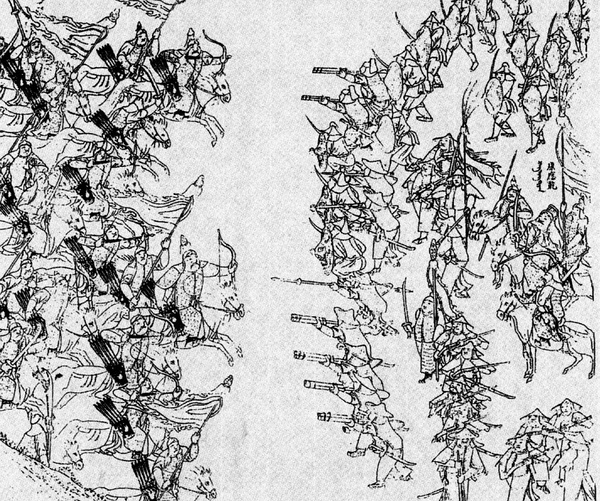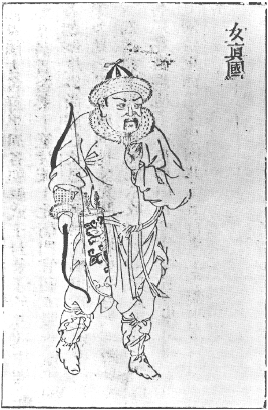|
Prince Ying (θ±)
Prince Ying of the First Rank, or simply Prince Ying, was the title of a princely peerage used in China during the Manchu-led Qing dynasty (1644β1912). As the Prince Ying peerage was not awarded "iron-cap" status, this meant that each successive bearer of the title would normally start off with a title downgraded by one rank ''vis-Γ -vis'' that held by his predecessor. However, the title would generally not be downgraded to any lower than a ''feng'en fuguo gong'' except under special circumstances. The first bearer of the title was Ajige (1605β1651), the 12th son of Nurhaci, the founder of the Qing dynasty. In 1644, Ajige was granted the title "Prince Ying of the First Rank" by his nephew, the Shunzhi Emperor. However, in 1651, he was stripped of his title and forced to commit suicide after his failed attempt to seize the position of Prince-Regent after Dorgon's death. The peerage was passed down over 12 generations and held by 15 persons. Members of the Prince Ying peerag ... [...More Info...] [...Related Items...] OR: [Wikipedia] [Google] [Baidu] |
Royal And Noble Ranks Of The Qing Dynasty
The Qing dynasty (1636β1912) of China developed a complicated peerage system for royal and noble ranks. Rule of inheritance In principle, titles were downgraded one grade for each generation of inheritance. * Direct imperial princes with the ''Eight Privileges'' were downgraded for four generations, after which the title can be inherited without further downgrades. * Direct imperial princes without the ''Eight Privileges'' were downgraded until the rank of ''feng'en jiangjun'', which then became perpetual. * Cadet line imperial princes and lords were downgraded until they reached ''feng'en jiangjun'', which could be further inherited three times before the title expired completely. * For non-imperial peers, the title could be downgraded to ''en jiwei'' before becoming perpetually heritable. Occasionally, a peer could be granted the privilege of ''shixi wangti'' (; "perpetual heritability"), which allowed the title to be passed down without downgrading. Throughout the Qing ... [...More Info...] [...Related Items...] OR: [Wikipedia] [Google] [Baidu] |
Manchu People
The Manchus (; ) are a Tungusic East Asian ethnic group native to Manchuria in Northeast Asia. They are an officially recognized ethnic minority in China and the people from whom Manchuria derives its name. The Later Jin (1616β1636) and Qing (1636β1912) dynasties of China were established and ruled by the Manchus, who are descended from the Jurchen people who earlier established the Jin dynasty (1115β1234) in northern China. Manchus form the largest branch of the Tungusic peoples and are distributed throughout China, forming the fourth largest ethnic group in the country. They can be found in 31 Chinese provincial regions. Among them, Liaoning has the largest population and Hebei, Heilongjiang, Jilin, Inner Mongolia and Beijing have over 100,000 Manchu residents. About half of the population live in Liaoning and one-fifth in Hebei. There are a number of Manchu autonomous counties in China, such as Xinbin, Xiuyan, Qinglong, Fengning, Yitong, Qingyuan, Weichang, Kua ... [...More Info...] [...Related Items...] OR: [Wikipedia] [Google] [Baidu] |
Qing Dynasty
The Qing dynasty ( ), officially the Great Qing,, was a Manchu-led imperial dynasty of China and the last orthodox dynasty in Chinese history. It emerged from the Later Jin dynasty founded by the Jianzhou Jurchens, a Tungusic-speaking ethnic group who unified other Jurchen tribes to form a new "Manchu" ethnic identity. The dynasty was officially proclaimed in 1636 in Manchuria (modern-day Northeast China and Outer Manchuria). It seized control of Beijing in 1644, then later expanded its rule over the whole of China proper and Taiwan, and finally expanded into Inner Asia. The dynasty lasted until 1912 when it was overthrown in the Xinhai Revolution. In orthodox Chinese historiography, the Qing dynasty was preceded by the Ming dynasty and succeeded by the Republic of China. The multiethnic Qing dynasty lasted for almost three centuries and assembled the territorial base for modern China. It was the largest imperial dynasty in the history of China and in 1790 the f ... [...More Info...] [...Related Items...] OR: [Wikipedia] [Google] [Baidu] |
Aisin Gioro
The House of Aisin-Gioro was a Manchu clan that ruled the Later Jin dynasty (1616β1636), the Qing dynasty (1636β1912), and Manchukuo (1932β1945) in the history of China. Under the Ming dynasty, members of the Aisin Gioro clan served as chiefs of the Jianzhou Jurchens, one of the three major Jurchen tribes at this time. Qing bannermen passed through the gates of the Great Wall in 1644, conquered the short-lived Shun dynasty and the Southern Ming dynasty. The Qing dynasty later expanded into other adjacent regions, including Xinjiang, Tibet, Outer Mongolia, and Taiwan, gaining total control of China. The dynasty reached its zenith during the High Qing era and under the Qianlong Emperor, who reigned from 1735 to 1796. This reign was followed by a century of gradual decline. The house lost power in 1912 following the Xinhai Revolution. Puyi, the last Aisin-Gioro emperor, nominally maintained his imperial title in the Forbidden City until the Articles of Favourable Treatm ... [...More Info...] [...Related Items...] OR: [Wikipedia] [Google] [Baidu] |
Ajige
Ajige (Manchu:, MΓΆlendroff: ajige; 28 August 1605 β 28 November 1651) was a Manchu prince and military general of the early Qing dynasty. He was born in the Aisin Gioro clan as the 12th son of Nurhaci, the khan of the Later Jin dynasty (the precursor of the Qing dynasty). Ajige was conferred the title "Prince Wuying of the Second Rank" (ζ¦θ±ι‘η) in 1636, before being promoted to " Prince Ying of the First Rank" in 1644. He was involved in the Manchu conquest of the Ming dynasty. After the death of Dorgon, Ajige attempted to seize the position of Prince-Regent (previously held by Dorgon), but was discovered and placed under arrest. He was forced to commit suicide by the Shunzhi Emperor in 1651. Physical Appearance According to the account of Japanese travellers, Ajige was a stalwart, valiant and hot-tempered warrior who had been through numerous battles, and that he had eyes that looked abnormally ferocious. Family Primary Consort * First primary consort, of the ... [...More Info...] [...Related Items...] OR: [Wikipedia] [Google] [Baidu] |
Nurhaci
Nurhaci (14 May 1559 β 30 September 1626), also known by his temple name as the Emperor Taizu of Qing (), was a Jurchen chieftain who rose to prominence in the late 16th century in Manchuria. A member of the House of Aisin-Gioro, he reigned as the founding khan of the Later Jin dynasty of China from 1616 to 1626. Nurhaci reorganized and united various Jurchen tribes (the later "Manchu"), consolidated the Eight Banners military system, and eventually launched attacks on both the Ming and Joseon dynasties. His conquest of Ming dynasty's northeastern Liaodong region laid the groundwork for the Qing conquest of the Ming by his descendants, who founded the Qing dynasty in 1636. He is also generally credited with ordering the creation of a new written script for the Manchu language based on the Mongolian vertical script. Name and titles Nurhaci is written as in Manchu language. Some suggest that the meaning of the name in the Manchu language is "the skin of a wild boar", other ... [...More Info...] [...Related Items...] OR: [Wikipedia] [Google] [Baidu] |
Shunzhi Emperor
The Shunzhi Emperor (15 March 1638 β 5 February 1661) was the second Emperor of China, emperor of the Qing dynasty of China, and the first Qing emperor to rule over China proper, reigning from 1644 to 1661. A Deliberative Council of Princes and Ministers, committee of Manchu princes chose him to succeed his father, Hong Taiji (1592β1643), in September 1643, when he was five years old. The princes also appointed two co-regents: Dorgon (1612β1650), the 14th son of the Qing dynasty's founder Nurhaci (1559β1626), and Jirgalang (1599β1655), one of Nurhaci's nephews, both of whom were members of the Aisin Gioro, Qing imperial clan. From 1643 to 1650, political power lay mostly in the hands of Dorgon. Under his leadership, the Qing Empire conquered most of the territory of the fallen Ming dynasty (1368β1644), chased Southern Ming, Ming loyalist regimes deep into the southwestern provinces, and established the basis of Qing rule over China proper despite highly unpopular ... [...More Info...] [...Related Items...] OR: [Wikipedia] [Google] [Baidu] |
Prince Regent
A prince regent or princess regent is a prince or princess who, due to their position in the line of succession, rules a monarchy as regent in the stead of a monarch regnant, e.g., as a result of the sovereign's incapacity (minority or illness) or absence (e.g., by remoteness, such as exile or long voyage, or the absence of an incumbent). While the term itself can have the generic meaning and refer to any prince or princess who fills the role of regent, historically it has mainly been used to describe a small number of individual princes and princesses who were regents of non-principalities. Prince regent in the United Kingdom In the English language the title ''Prince Regent'' is most commonly associated with George IV, who held the style ''HRH'' The Prince Regent during the Regency era, the incapacity, by dint of mental illness, of his father, George III (see Regent for other regents). Regent's Park, Regent Street and Regent's Canal (which he commissioned) in London, were a ... [...More Info...] [...Related Items...] OR: [Wikipedia] [Google] [Baidu] |
Dorgon
Dorgon (, ; 17 November 1612 β 31 December 1650), was a Manchu prince and regent of the early Qing dynasty. Born in the House of Aisin-Gioro as the 14th son of Nurhaci (the founder of the Later Jin dynasty, predecessor of the Qing dynasty), Dorgon started his career in military campaigns against the Ming dynasty, Mongols and Koreans during the reign of his eighth brother, Hong Taiji, who succeeded their father. After Hong Taiji's death in 1643, he was involved in a power struggle against Hong Taiji's eldest son, Hooge, over the succession to the throne. Both of them eventually came to a compromise by backing out and letting Hong Taiji's ninth son, Fulin, become the emperor; Fulin was installed on the throne as the Shunzhi Emperor. Dorgon served as Prince-Regent from 1643 to 1650, throughout the Shunzhi Emperor's early reign. In 1645, he was given the honorary title "Emperor's Uncle and Prince-Regent" (ηεηΆζζΏη); the title was changed to "Emperor's Father and Pri ... [...More Info...] [...Related Items...] OR: [Wikipedia] [Google] [Baidu] |
Draft History Of Qing
The ''Draft History of Qing'' () is a draft of the official history of the Qing dynasty compiled and written by a team of over 100 historians led by Zhao Erxun who were hired by the Beiyang government of the Republic of China. The draft was published in 1928, but the Chinese Civil War caused a lack of funding for the project and it was put to an end in 1930. The two sides of the Chinese civil war, the People's Republic of China and Republic of China have attempted to complete it. History The Qing imperial court had long established a Bureau of State Historiography and precompiled its own dynastic history. The massive book was started in 1914, and the rough copy was finished in about 1927. 1,100 copies of the book were published. The Beiyang government moved 400 of the original draft into the northern provinces, where it re-edited the content twice, thus creating three different copies of the book. It was banned by the Nationalist Government in 1930. Historian Hsi-yuan Chen writ ... [...More Info...] [...Related Items...] OR: [Wikipedia] [Google] [Baidu] |



%2C_by_Henry_Bone.jpg)
